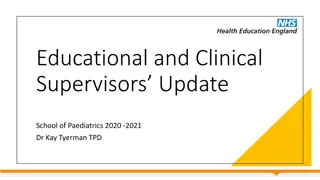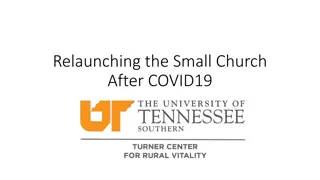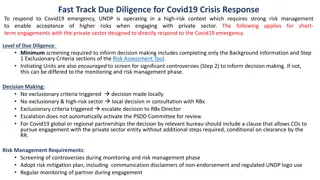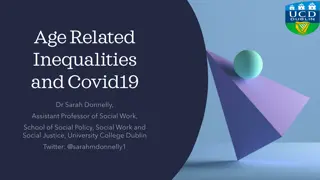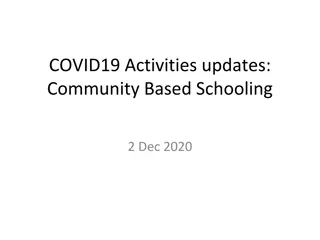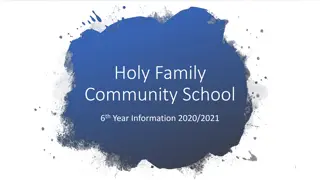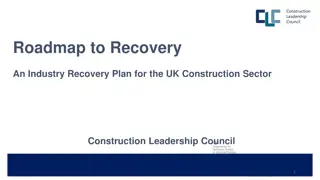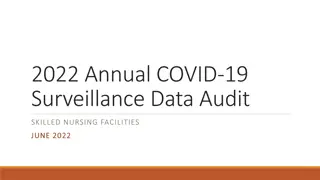
Insights into Challenges Faced by BME Communities Amid COVID-19
Early research is shedding light on the increased harms BME communities are facing due to COVID-19, with socio-economic factors playing a significant role. The pandemic has heightened demands on third sector services and strained public bodies, leading to significant changes in service delivery practices. The third sector has responded with activism and strategic litigation, prompting reflections on the impact of the hostile environment. Existing harms experienced by migrant families due to immigration controls are exacerbated during this crisis, impacting the safety net for children and young people. Changes in policies affecting migrant communities have brought about both successes and challenges, highlighting complexities in support provision.
Download Presentation

Please find below an Image/Link to download the presentation.
The content on the website is provided AS IS for your information and personal use only. It may not be sold, licensed, or shared on other websites without obtaining consent from the author. If you encounter any issues during the download, it is possible that the publisher has removed the file from their server.
You are allowed to download the files provided on this website for personal or commercial use, subject to the condition that they are used lawfully. All files are the property of their respective owners.
The content on the website is provided AS IS for your information and personal use only. It may not be sold, licensed, or shared on other websites without obtaining consent from the author.
E N D
Presentation Transcript
A brief introduction Why are we here Early research(1) is beginning to identify increased harms from COVID-19 in BME communities. The research has put forward theories including (though not exclusively) socioeconomic circumstances as a potential contributing factor. The COVID-19 crisis has placed additional demands on third sector services, as well as undoubtedly placing significant strain on local authorities and other public bodies. In addition, working practices have been forced to change across the board, which adds a layer of complexity to delivering services. The third sector has responded to the pandemic with a raft of challenge, campaigning and strategic litigation, which needs looking at both in terms of a response now and future reflections on the hostile environment. 1) NHS Confederation (2020); The impact of COVID-19 on BME communities and health and care staff; available at https://www.nhsconfed.org/resources/2020/04/the- impact-of-covid19-on-bme-communities-and-staff
A brief introduction Existing harms In normal times, there is already a great deal of harm experienced by children and families subject to immigration controls. The hostile immigration environment is well documented(2) as contributing to existing harms of migrant families. Denial of access to existing welfare provision and gatekeeping in statutory social work serviceslead to children and young people being deprived of a basic safety net(3), or provides one that meets only the very basic of needs(4). This climate can be seen through the lens of statutory neglect (5), that impacts on the provision of support to vulnerable children and young people. The policies and subsequent practice response exacerbates social exclusion and arguably widens inequalities, as well as creating a secondary hostile environment in children s safeguarding and wider welfare provision. 2) Global Justice Now (2018); The Hostile Environment for Immigrants; available at https://www.globaljustice.org.uk/sites/default/files/files/resources/hostile_environment_briefing_feb_2018_web.pdf 3) Project 17 (2019); Not Seen, Not Heard, children s experiences of the hostile environment; available at https://www.project17.org.uk/media/70571/Not-seen-not-heard-1-.pdf 4) Children s Society (2020); A lifeline for all: Children and Families with No Recourse to Public Funds; Available at https://www.childrenssociety.org.uk/sites/default/files/a-lifeline- for-all-report.pdf 5) Jolly, A (2018); No Recourse to Social Work? Statutory Neglect, Social Exclusion and Undocumented Migrant Families in the UK; Social Inclusion (6)(3).
A brief introduction A changing context Throughout the COVID-19 crisis, a series of changes, both legal and policy have been brought in which impact migrant communities, such as; Suspension of reporting for those on immigration bail. Delays in screening interviews for asylum seekers. Suspension of assisted voluntary return. Changes to homelessness provision. Temporary extension of free school meals eligibility criteria. For migrant families with NRPF, the traditional support route of Section 17 remains the dominant mode of support in destitution. With it s usual exclusion caveats, it is interesting to think about COVID-19 in the context of the human rights assessment. From a policy perspective, it has been a mixed bag of successes and challenges. There has also been the creation of many dilemmas, in the context of messaging to the public during this crisis and how it matches the support actually being offered and provided.
Is it safety? case extract Temi has 2 children born in the UK and is pregnant. She is a Nigerian national. She has no leave to remain in the UK, having overstayed a visa 12 years ago. She is not eligible under the immigration rules to make an application for leave to remain. Temi had previously not sought maternity care because of concerns over NHS charging and reporting to the Home Office. In the height of lockdown , the friend that they were staying with kicked them out the house leaving them homeless. The family has a limited support network and having been without status for so long, had exhausted the majority of their network. The school is not providing free school meals for the children, as they have no duty to do so. The limited money available to the family is small amounts gifted by friends, family and the church. Homeless, the midwife made a safeguarding referral to a local authority, who accommodated the family under Section 17 Children Act 1989.
Mixed messages: case extract Esther and her family got their leave to remain after an 8 year battle. They received it a week before lockdown started. Despite being destitute and in receipt of support under Section 17, it was granted with a condition of No Recourse to Public Funds (NRPF). The accommodation they were in was a house of multiple occupancy, with Esther and her daughter occupying one room of 6. The family assumed because of public health messaging that they would be given safety and work towards their own home and have more support than the 77 per week they are currently living on. Given the changes to free school meals, they were eligible for free school meals, but required advocacy to guide the school through the eligibility criteria and evidence requirements. I get 77 [a week]. I couldn t afford to follow the guide. I had to buy little and go out a lot. The shops I use, they are closed, only expensive supermarkets left. My daughter, she is scared that someone in the house might have the virus. No school, I have no computer, she is doing her homework on my broken phone.
The perils of help and support In ordinary circumstances, certain groups of people are excluded from accessing support from social services. A local authority must do a human rights assessment to ascertain if a family can freely return (6). COVID-19 arguably presents a practical barrier, given the assisted voluntary return scheme and most travel has been severely disrupted. LA s should arguably provide support in this instance. However, from some this is fraught with other risks. In the case of Temi, who is a few years off a route to make an application, this support will likely be limited to COVID-19. Seeking support means immediate protection from street homelessness, but long term risk in terms of immigration control and longevity of support. Consideration must be given the sharing of information between social services and the Home Office in terms of families being supported. There is currently a free for all of sharing between public authorities and immigration enforcement in the UK(7). 6) NRPF Network (nd.); Assessing and supporting families with No Recourse to Public Funds; Available at http://guidance.nrpfnetwork.org.uk/reader/practice-guidance- families/pre-assessment-screening/ Hermansson et al (2020); Firewalls: A necessary tool to enable social rights for undocumented migrants in social work; International social work; Available at https://journals.sagepub.com/doi/10.1177/0020872820924454 7)
Mixed messaging The government corona safety net (8) largely excludes people subject to immigration control, especially those with no leave to remain and those with the NRPF condition. Messaging that has been delivered and indeed filtered through communities, is arguably one of a universal safety net. The homelessness provision brought in is exactly that and mainly delivered through street outreach. On the whole, for migrant families, the same barriers and exclusions apply as before. The financial system for supporting families during the crisis is largely based on the existing welfare safety net. This ordinarily, and now, excludes the vast majority of this group of families. It is telling when a question about NRPF was put to the Prime Minister, he seemed blissfully unaware of the restrictions placed on many families.(9) 8) 9) HM Government (2020); COVID-19 guidance and support; available at https://www.gov.uk/coronavirus JCWI (2020); Our joint letter to the Prime Minister: it s time to scrap NRPF ; available at: https://www.jcwi.org.uk/our-joint-letter-to-the-prime-minister-its-time-to-scrap- nrpf
Public health impact There is a small body of research that suggests NHS charging for overseas visitors is harmful to public health(10). For instance, with Temi, she delayed seeking maternity care because of healthcare charging. One of the parents we work with said this about healthcare charging; It s like the virus doesn t care who it kills, but the government wants to choose who it save[s] . Another family we work with, whose child has a serious lung condition and is currently undergoing treatment, was refused support by a local authority despite the fact they were one of 4 households sharing a 3 bedroom home. The combination of inadequate housing, poverty and hostile environment measures, including no access to the safety net, is a public health emergency that deserves serious attention. 10) Britz & McKee (2016); Charging Migrants for healthcare could compromise public health and increase costs for the NHS; Journal of Public Health; 38(2).
The response There has been lots of campaigning across the sector, primarily calling for; Increased rates of asylum support Abolishment / suspension of NRPF Various challenges focused on different elements of destitution Amongst this, there have been some significant achievements; A successful challenge to the application of NRPF and a lack of access to the welfare safety net(11) An extension (albeit temporary) of free school meals to several additional groups of child harmed by immigration controls(12). It would seem that there has been a far harsher spotlight on immigration controls in recent weeks, as the hostile environment takes one knock after another. 11) The Unity Project (2020); High Court ruling over no recourse to public funds delivers further blow to Home Office s discredited hostile environment policy ; Available at https://www.unity-project.org.uk/suspend-nrpf Department for Education (2020); Temporary extension of free school meals eligibility to NRPF groups , Available at https://www.gov.uk/government/publications/covid- 19-free-school-meals-guidance/guidance-for-the-temporary-extension-of-free-school-meals-eligibility-to-nrpf-groups 12)
The NRPF judgement Concerned an 8 year old British child and his mother. Judgement handed down found that the application of NRPF on the 10 year route this family was on was unlawful(13). The remedy has been a change in guidance(14) which worryingly gives the Home Office still a great deal of discretion in how the NRPF policy is delivered. There is a significant statement of it being mandatory not to impose the condition . Having provided evidence that they are destitute (pp.88). Regardless of the remedy however, it can be seen as a significant blow to an inflated hostile environment policy that has diminished the rights of migrant families for a long period of time. 13) R (W, A child by his litigation friend J) v The Secretary of State for the Home Department & Anor (2020); EWHC 1299 (Admin); Available at https://www.bailii.org/ew/cases/EWHC/Admin/2020/1299.html Home Office (2020); Family policy: Family life (as a partner or parent), private live and exceptional circumstances (pp. 87-93); Available at https://assets.publishing.service.gov.uk/government/uploads/system/uploads/attachment_data/file/888768/family-life-_as-a-partner-or-parent_-private-life-and- exceptional-circumstances-v7.0ext.pdf 14)
Some thoughts on campaign goals and aims Most campaigning and indeed achievements in this period have related to children and families who have leave to remain, with a condition of NRPF. This goes for the NRPF judgement and the free school meals extension. There is a distinct gap in considering the needs of undocumented children and families without leave to remain in the United Kingdom. Jolly et al (2020) when looking at the figures in London alone, estimate there are 397,000 undocumented migrants with their UK born in children living in the capital(15) as a small example of the scale of the issue. There has been no movement in policy acknowledging those without leave to remain. Famously, the long standing aim of the hostile environment has been to create a really hostile environment for illegal immigration (16). 15) Jolly et al (2020); London s children and young people who are not British Citizen s a profile ; Mayor of London; Available at https://www.london.gov.uk/sites/default/files/final_londons_children_and_young_people_who_are_not_british_citizens.pdf. Grierson (2018); Hostile environment: Anatomy of a policy disaster; The Guardian; Available at https://www.theguardian.com/uk-news/2018/aug/27/hostile- environment-anatomy-of-a-policy-disaster. 16)
Providing support We asked families currently working with us what they think is most helpful at the moment. They told us; Help understanding the [support] rules. Someone to stand next to me when it was difficult I know my rights now, this makes me more comfortable with the [social services] worker You [TwMC] topping up my phone. I have enough data for school at home now. The issue remains that there is not enough support. The sector is small and with limited capacity. This impacts everything from immigration resolutions to destitution support and being able to also meet crisis needs. When considering the landscape of support, it is important to consider the intersect between immigration law, hostile environment policy and the law and policy designed to keep children safe.
Providing support There are questions that need to be considered about values and ethics, in a landscape within a local authority that can be very hostile and applying legal frameworks that are openly and plainly there to make life very hostile . In the context of the pandemic, immediate safety must be thought about from both a safeguarding and public health point of view. However, that immediate safety must be thought about in terms of longer term risk, impact of the hostile environment and what will happen after COVID-19. This is why clear advice, rights education and a careful, slow way of practice is essential when working with families who occupy this complex space. This requires a legally literate, anti-racist practice focus.
Twitter: @nickinoxford Email nick.watts@togethermigrantchildren.org.uk

